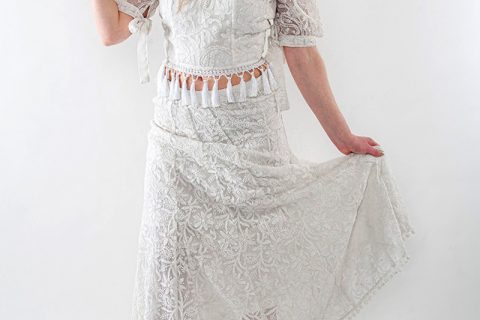
A Beginner’s Guide to Understanding Chikankari Embroidery
- By indirabishen
- Posted on
A Beginner’s Guide to Understanding Chikankari Embroidery
Chikankari, the delicate hand embroidery from Lucknow, is a hallmark of Indian craftsmanship. Known for its intricate patterns and timeless elegance, Chikankari has adorned royal attire for centuries. This guide will help beginners understand this art, its history, techniques, and modern applications in luxury fashion.
History of Chikankari Embroidery
Basic Techniques of Chikankari
- Back Stitch (Taanka): Forms the outline of motifs.
- Shadow Work (Pakko or Bakhya): Creates subtle effects on sheer fabrics.
- Floral and Geometric Stitches: Used for embellishing sarees, kurtis, and dresses.
- Darning (Murri, Bakhiya, Phanda): Adds depth and texture to embroidery.
Modern Applications of Chikankari
- Gowns & Dresses: Contemporary silhouettes with delicate embroidery.
- Jackets & Tunics: Perfect for casual and formal occasions.
- Fusion Wear: Mixing Chikankari with modern fabrics, colors, and cuts for a stylish look.
Caring for Chikankari Garments
- Hand wash or gentle dry-clean.
- Store in breathable fabric covers to avoid damage.
- Avoid harsh chemicals and direct sunlight to protect delicate threads.
The Artisan’s Touch: Heart Behind Every Stitch
Every piece of authentic Chikankari is a result of countless hours of meticulous work by skilled artisans—many of whom are women from rural communities around Lucknow.
The process begins with design tracing, followed by hand embroidery, washing, and finishing.
Unlike machine-made imitations, hand-embroidered Chikankari carries a distinct human touch—slight imperfections that add to its charm and authenticity. Supporting these artisans helps preserve an art form that might otherwise fade in the era of fast fashion.
Recognizing Authentic Chikankari
For beginners and buyers, it’s important to know how to identify genuine Chikankari work:
-
Examine the Back Side: Original Chikankari shows visible knots and uneven threadwork.
-
Feel the Fabric: Authentic pieces are usually soft and airy, made of cotton, muslin, or chiffon.
-
Look for Subtle Imperfections: Perfectly symmetrical patterns often indicate machine embroidery.
-
Price Factor: Handcrafted pieces take days to complete; unusually low prices may suggest replicas.
By investing in authentic Chikankari, you not only get a unique garment but also support centuries-old craftsmanship.
Chikankari in Global Fashion
Over the last decade, Chikankari has crossed Indian borders and found a place on global runways. Designers are combining traditional embroidery with contemporary silhouettes to appeal to modern audiences.
Celebrities and influencers around the world are embracing Chikankari for its elegance, comfort, and versatility. From red-carpet gowns to everyday chic kurtas, this age-old embroidery now represents sustainable, slow luxury—a perfect blend of heritage and modernity.
Learn more about Chikankari:https://en.wikipedia.org/wiki/Chikankari
“Follow us on Pinterest for our latest Chikankari collection inspirations.”
https://www.pinterest.com/indirabishen/
FAQs
Q.1: What is Chikankari embroidery?
Chikankari is a traditional hand embroidery technique that originated in Lucknow, India. It involves delicate and intricate threadwork—usually white on pastel fabrics—featuring floral, paisley, and geometric patterns.
Q.2:What fabrics are used for Chikankari?
Chikankari embroidery is most commonly done on lightweight, breathable fabrics such as cotton, muslin, chiffon, georgette, silk, and organza. The fabric choice enhances the fine detailing and soft texture of the embroidery.
Q.3: How can I identify original Chikankari work?
To identify authentic Chikankari:
Check the back side—hand embroidery shows visible knots and uneven threads.
Feel the texture—it should be soft and slightly raised.
Watch for minor imperfections, which indicate handmade craftsmanship.
Machine embroidery looks perfectly uniform and often lacks depth.
Conclusion
From royal Mughal courts to modern fashion ramps, Chikankari embroidery continues to enchant with its delicate charm and artistic depth. For beginners, understanding this art means appreciating the handmade excellence, cultural legacy, and sustainable value it holds.
Whether you choose a soft cotton kurti or a designer gown, every Chikankari piece connects you to centuries of craftsmanship. In a world racing toward modernity, Chikankari reminds us that true beauty lies in patience, precision, and the human touch.
To Know More-
Visit: https://indirabishen.com/





